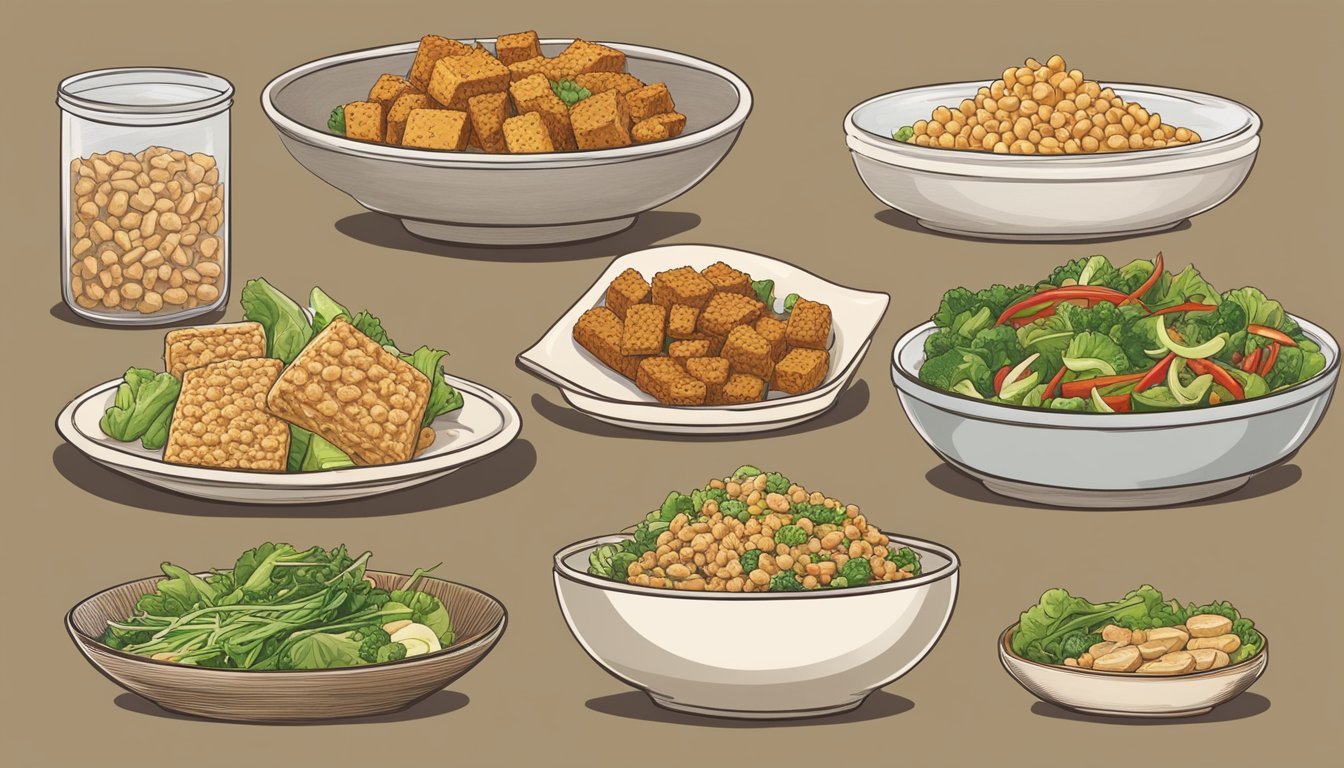How to Substitute Tempeh for Tofu
A Guide for Seamless Swaps
Substituting tempeh (What wine goes well with tempeh?) for tofu in recipes is a straightforward way to bring a different set of flavors and textures to plant-based dishes. While tofu is known for its mild taste and its ability to absorb flavors from other ingredients, tempeh offers a nutty and earthy profile that can enhance the savory notes of a meal. Derived from soybeans, both tempeh and tofu are excellent sources of protein and are favored in vegetarian and vegan cooking for their versatility and nutritional benefits.
Tempeh's unique texture, which is firmer and grainier than that of tofu, holds up well during cooking and can be sliced or cubed as a direct substitution in most dishes. It does not require pressing, unlike some forms of tofu, saving time and effort in meal preparation. The fermentation process that tempeh undergoes not only contributes to its distinct flavor but also makes it beneficial for digestive health. When introducing tempeh as a tofu substitute, one can start with a simple 1:1 ratio, adjusting as necessary for personal taste and recipe specificity.
Understanding Tofu and Tempeh
To effectively substitute tempeh for tofu, one should understand their origins, composition, and nutritional profiles. Both are soy-based proteins yet distinct in preparation and characteristics.
What Is Tofu?
Tofu originates from China and is a soft, cheese-like food made by coagulating soy milk and pressing the resulting curds into blocks. It's known for its mild flavor and ability to absorb the tastes of other ingredients. Tofu is a versatile food used across various Asian cuisines and comes in multiple textures, from silky to extra firm.
Nutrition: Lower in calories and fat; contains protein, calcium, and iron.
Uses: Can be fried, baked, scrambled, or used in soups and sauces.
Exploring Tempeh Origins
Tempeh hails from Indonesia and is a traditional food made by fermenting soybeans with a starter culture. This fermentation binds the beans into a dense, cake-like form. Tempeh has a nutty flavor and a heartier texture compared to tofu.
Fermentation: Enhances digestion; increases content of certain vitamins and fiber.
Components: Often includes a mix of soybeans with other grains, seeds, or legumes.
Nutritional Comparison
When comparing tofu and tempeh, one finds both to be nutritious soy products with important differences.
Nutrient Tofu (per 100g) Tempeh (per 100g) Calories Lower Higher Protein Approx. 8g Approx. 19g Fat Lower Higher Fiber Less More Vitamins Contains fewer More varied due to fermentation Minerals High in calcium Contains iron and potassium
While tofu is a great low-calorie protein source, tempeh offers more protein and fiber, making it exceptionally nutritious. Both provide key nutrients and serve as fundamental components in a plant-based diet.
Substituting Tempeh for Tofu in Cooking
When replacing tofu with tempeh, one must consider the distinct texture and flavor tempeh brings to a dish. Tempeh, which is firmer and has a nuttier taste than tofu, can add a new dimension to recipes traditionally made with tofu.
Swapping in Recipes
To substitute tempeh for tofu in a recipe, one typically uses a 1:1 ratio. If the recipe calls for soft or silken tofu, tempeh can often provide a different texture, as it is naturally firmer. For dishes that require extra firm tofu, tempeh is an excellent alternative. Steaming tempeh for about 10 minutes can soften it slightly, which makes it more similar to tofu's consistency and allows it to absorb flavors more effectively.
Marinating Techniques
Tempeh's dense structure makes it ideal for marinating. Unlike tofu, tempeh does not need to be pressed to remove excess moisture. To marinate tempeh, one should slice or cube it and then soak it in a flavorful liquid. Ingredients such as soy sauce, rice vinegar, and spices help the tempeh absorb a rich flavor profile. Longer marination times are recommended, with at least an hour or up to overnight to achieve a depth of flavor.
Textural Considerations
The texture of tempeh is one of the key differences when using it in place of tofu. Its firmness provides a satisfying chew that stands up well to various cooking methods, such as frying and baking. When preparing a dish that typically uses crumbled tofu, like a tofu scramble, one should crumble tempeh with a fork or hands to reach the desired consistency.
Adjusting Cooking Times
Tempeh may require adjustments to cooking times compared to tofu. Due to its density, it usually takes longer to cook through. When frying or sautéing tempeh, one should do so on medium heat for about 5 to 10 minutes on each side until it's golden brown. For baking, tempeh should be cooked at a moderate temperature, typically around 350°F (177°C), for 20 to 30 minutes, depending on the recipe. Cooking times may vary based on whether tempeh is marinated or cut into thick or thin slices.
Choosing the Right Tempeh
When substituting tempeh for tofu, one must consider both the form and flavor profile of the tempeh to ensure it complements the dish they are preparing. The form will affect the texture and the flavor will either add a new dimension or blend seamlessly with other ingredients.
Blocks vs. Crumbled
Blocks of tempeh are ideal for slicing or cutting into cubes, and they maintain their structure well during cooking. This makes them suitable for grilling, frying, or baking, where a firm texture is desired.
Firmness: Blocks hold up well in cooking
Uses: Grilling, frying, baking
In contrast, crumbled tempeh is perfect for dishes that require a ground meat-like consistency, such as in tacos or sauces.
Texture: Crumbled provides a ground meat-like texture
Uses: Tacos, sauces, stir-fries
Flavored vs. Plain
Flavored tempeh is already marinated or seasoned with spices, soy sauce, or other ingredients, imparting a distinct taste that can enhance the dish. It's a good choice for simple recipes where the tempeh is a centerpiece.
Taste: Enhanced with spices, soy sauce, etc.
Consideration: Complements or contrasts the recipe's flavor profile
Plain tempeh retains a neutral flavor with a subtle nutty undertone, making it a versatile ingredient. It readily absorbs flavors from marinades and sauces, giving cooks the flexibility to tailor the taste as needed for their specific recipes.
Flavor: Neutral with a nutty background
Adaptability: Absorbs flavors well when marinated
Health Benefits and Dietary Considerations
When substituting tempeh for tofu, individuals often consider the health benefits and dietary requirements associated with these plant-based proteins. This section explores the advantages these soy products offer, particularly for vegetarian and vegan diets, as well as their allergen and gluten content.
Advantages for Vegetarian and Vegan Diets
Vegetarians and vegans reap significant benefits from integrating tempeh into their diets due to its high-quality plant-based protein content. Tempeh is not only a complete protein source containing all essential amino acids but also rich in nutrients like iron and potassium. Unlike tofu, which is coagulated soy milk, tempeh is made from fermented soybeans, a process enhancing its nutritional profile by increasing its fiber content and improving digestibility. For those on a vegetarian or vegan diet, tempeh can provide crucial nutrients that might be less accessible through other sources.
Key Nutritional Components:
Protein: Essential for muscle repair and growth
Iron: Vital for blood oxygenation
Potassium: Important for muscle and nerve function
Fiber: Aids in digestion and satiety
Furthermore, tempeh contains naturally occurring health benefits from the fermentation process, such as promoting gut health.
Allergens and Gluten Content
Awareness of allergens is crucial for those considering tempeh. Although tempeh is a soy-based product, which is a common allergen, many people find it to be a suitable part of a gluten-free diet. However, individuals must inspect labels carefully as some tempeh products may contain added grains containing gluten or be processed in facilities that handle wheat products.
Gluten-free: Generally, pure tempeh without additives is gluten-free.
Soy Allergies: As tempeh is derived from soybeans, those with soy allergies should avoid it.
It is recommended that individuals with allergies consult with healthcare professionals or nutritionists before incorporating tempeh into their diet.
Tempeh Preparation Techniques
Preparing tempeh correctly can make a significant impact on the texture and flavor, ensuring it provides a satisfactory substitute for tofu in various dishes. The following approaches highlight methods to cook tempeh to perfection, whether it is being fried or baked, and offer recipe adaptation ideas for using tempeh in meals like salads, sandwiches, tacos, and more.
Cooking Tempeh to Perfection
Frying:
Slice tempeh into thin strips for quick and even frying.
Heat a non-stick pan with a small amount of oil over medium heat, then add the tempeh, frying until golden brown on both sides.
Baking:
Preheat the oven to 400°F (200°C).
Cut tempeh into cubes or quarter-inch-thick slices.
Place on a lined baking sheet and bake until crispy, flipping halfway through.
Pre-cooking for other dishes:
It's advisable to pre-cook tempeh by steaming or simmering in water for 10 minutes to remove any bitterness.
After pre-cooking, tempeh can be incorporated into stir fry, curry, or soups for added texture.
Tips for frying and baking:
Marinate tempeh before cooking to infuse flavors.
Keep tempeh in a single layer without crowding to ensure even cooking.
Recipe Adaptation Ideas
Salads and Sandwiches:
Fry tempeh until crispy and add to salads for a protein-rich topping.
Marinated and grilled tempeh slices can serve as a hearty filling for sandwiches.
Tacos:
Crumble and fry tempeh with taco seasoning to replace ground meat in tacos.
Stir Fry and Curry:
Incorporate fried tempeh cubes into stir fry recipes or curries to add substance and absorb the surrounding flavors.
Soups:
Add sliced or crumbled tempeh into soups for enhanced texture and nutrition.
Adaptation tips:
Season tempeh generously with spices or marinades to complement the flavors of the dish it is being added to.
Adjust cooking time based on how the tempeh is cut; thinner slices cook faster.
Incorporating Tempeh into Varied Cuisines
Tempeh, a soy product originally from Indonesia, serves as a versatile meat alternative in many types of dishes due to its firm texture and ability to absorb flavors well. When substituting tofu for tempeh, one should consider the type of tofu used to retain the integrity of the cuisine's flavor profile.
Asian-Inspired Dishes
Soft Tofu: Often used in soups and stews, soft tofu can replace tempeh in dishes such as miso soup or soondubu jjigae. While it offers a different, softer texture, it still absorbs the broth's rich flavors, complementing the overall taste palette of these Asian dishes.
Firm Tofu: For stir-fries and noodle dishes, firm tofu is an excellent stand-in for tempeh due to its robust texture. Its ability to hold up to high-heat cooking makes it a prime choice for recipes such as pad thai or mapo tofu, where it can be cubed and sautéed with vegetables and sauces.
Extra Firm Tofu: When deep-fried, extra firm tofu achieves a crispy exterior ideal for replicating the denser bite of tempeh. It's especially effective in dishes where tempeh might be battered, such as in tempeh-based tempura, creating an appealing crunch and carrying the complex flavors of Asian sauces and seasonings.
Western Favorites
Seitan: (What wine goes well with seitan?) Known as wheat gluten, seitan is a popular meat substitute that mirrors the chewy texture of tempeh, making it a suitable replacement in Western cuisines. It works well in sandwiches, wraps, or as a protein in salads, readily taking on the smoky or savory seasonings typical of Western cooking.
Firm and Extra Firm Tofu: These types of tofu can be used in Western dishes that traditionally feature meat, providing a hearty and satisfying alternative. Firm and extra firm tofu can be grilled, baked, or scrambled, adapting to the culinary techniques of Western kitchens. One can marinate it in flavors such as barbecue or Italian herbs to enhance its appeal in dishes like burgers or pasta sauces.
By selecting the appropriate type of tofu and preparation method, one can seamlessly introduce tempeh's soy-based cousin into a wide array of cuisines, maintaining the cultural essence and satisfying the palate of diverse recipes.
Tempeh as Part of a Balanced Diet
Incorporating tempeh into one's diet offers a versatile approach to ensuring a balanced intake of both macro and micronutrients. Recognized for its high protein content, tempeh serves as an excellent source of plant-based proteins, making it a key element in meal planning for those seeking nutritious legume-based options.
Macro and Micronutrient Balancing
Tempeh, derived from fermented soybeans, is a nutrient-dense food providing a rich blend of essential macronutrients. A single serving typically contains:
Protein: Approximately 18 grams, contributing significantly to the daily protein requirement.
Fiber: Around 7 grams, aiding in digestive health.
Fat: About 10 grams, with a minimal amount of saturated fat.
Carbs: Close to 15 grams, offering a modest supply of energy.
In terms of micronutrients, tempeh is a notable source of iron, vital for oxygen transport in the blood, and also provides other minerals and vitamins, such as calcium and B vitamins. It compares favorably to other plant-based protein sources, such as quinoa, lentils, nuts, and seeds, each carrying their unique nutrient profiles.
Meal Planning with Tempeh
When including tempeh in a meal plan, one should consider its role in rounding out nutritional needs. Tempeh can replace animal proteins or complement other plant-based proteins like nuts and seeds. Its firm texture allows it to stand up to various cooking methods, and it readily absorbs flavors, making it a versatile component in many dishes.
Here are options for incorporating tempeh into a diet:
Breakfast: Crumbled into tofu scrambles for a protein boost.
Lunch: Sliced in sandwiches or salads, providing satisfying texture and substance.
Dinner: Marinated and served as a main dish alongside whole grains and vegetables.
By replacing conventional protein sources like meat with tempeh, individuals not only meet their protein requirements but also benefit from the addition of health-promoting fiber and a reduced intake of calories and saturated fats. This swap offers a heart-healthy alternative, reflecting the broader trend towards plant-based eating.
Creative Uses of Tempeh Beyond the Basics
Tempeh's versatility reaches well beyond traditional uses, offering a canvas for culinary innovation with its nutty flavor and hearty texture.
Innovative Tempeh Recipes
Those seeking meat alternatives find tempeh a substantial option. Tempeh recipes can easily incorporate a range of grains like barley to create hearty, satisfying dishes.
Marinated Tempeh Stir-fry: Marinate your tempeh with soy sauce, garlic, and ginger, then stir-fry with a medley of colorful vegetables and barley for a nutrient-packed meal.
Tempeh Reuben Sandwich: A creative twist on the classic, using thin slices of marinated and grilled tempeh topped with sauerkraut and Thousand Island dressing on rye bread.
Tempeh in Snacks and Light Meals
Tempeh's nutty flavor lends itself well to lighter fare like snacks and mini-meals.
Stuffed Mushrooms: Small button mushrooms filled with a mixture of crumbled tempeh, herbs, and breadcrumbs, baked until golden.
Tempeh Veggie Burgers: A delicious blend of grated cauliflower, chopped nuts, and tempeh make for a robust veggie burger patty; grill and serve with your favorite toppings.
Incorporating ingredients like cauliflower and eggplant allows tempeh to shine in various forms, from grilled slabs to seasoned crumbles, providing texture and protein to any dish.
Resources for Tempeh Enthusiasts
Tempeh enthusiasts have a wealth of information at their fingertips to elevate their cooking and enjoy this soy-based protein to its fullest. From detailed books with a plethora of recipes to supportive online communities, resources are abundant for both vegetarians and vegans.
Books and Cooking Guides
Books:
"Tempeh Cookbook" by Dorothy R. Bates offers a complete guide for preparing tempeh with a variety of recipes catering to different tastes and diets.
"The Art of Fermentation" by Sandor Ellix Katz, while broader in scope, includes insightful sections on making and cooking with tempeh.
Cooking Guides:
Online platforms such as Pantry & Larder provide step-by-step guides and innovative recipes specifically for tempeh, ranging from basic preparations to complex dishes.
Online Communities and Blogs
Blogs:
Happy Muncher and Tastylicious stand out for their dedicated sections on cooking with tempeh, offering unique recipes and substitution guidelines.
Bon Appétit features tempeh recipes with creative twists, appealing to foodies looking to expand their palate.
Online Communities:
Platforms like Reddit and plant-based forums have subgroups specifically for tempeh, where members share personal cooking tips, recipes, and culinary experiences.
Social media groups on Facebook and Instagram offer spaces for tempeh lovers to connect, showcasing how tempeh can be adapted to various cuisines and dietary needs.






